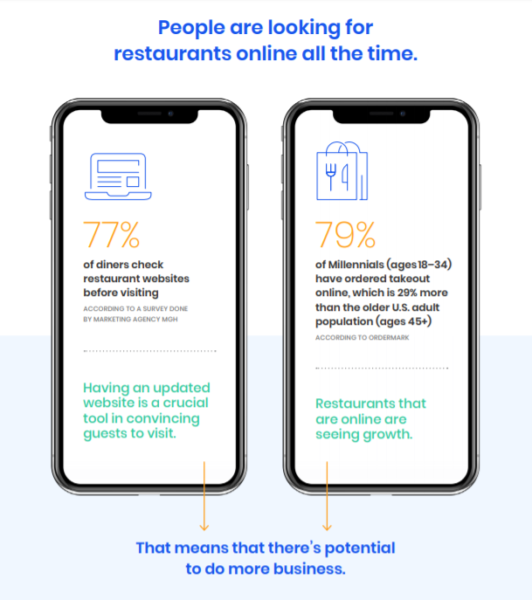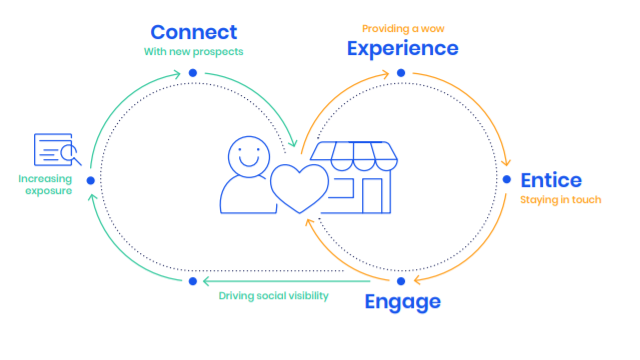
In the newest version of “normal,” there are plenty of stress points for the modern restaurant professional. Whether you’re new to the restaurant industry or a veteran of the business, we know you are working hard amid the pandemic to provide seamless service to your valued customers — from delivery and curbside innovations to reimagining the in-person dining experience.
As you adapt, you may be looking for fresh ways to connect with customers and continue to take your business to the next level. Perhaps you’ve heard of digital marketing, but you’re finding it overwhelming to take the plunge.
If this sounds familiar, you’re not alone! Navigating the restaurant industry in today’s world can be stressful, but online marketing doesn’t have to be.
Help new customers find you online
Did you know that 79% of millennials have ordered takeout online at least once? Imagine being able to connect with these key customers with fresh and relevant content. Restaurants who create an online presence are seeing significant growth by tapping into new customer markets.
So, how can you reap the major benefits of online marketing? This article will cover five online marketing strategies that every restaurateur should use:
- A mobile-responsive website
- An email marketing tool
- A primary social channel
- Up-to-date listings
- A way to easily create content
Understanding the tools and fundamentals of online restaurant marketing can help you draw in more customers and generate more revenue. Ready to get started? Read on to gain valuable knowledge about marketing your restaurant online.
Equip yourself with these five key tools from our free restaurant marketing guide to get started marketing your restaurant online.
A mobile-responsive website
Did you know that up to 77% of diners take a peek at a restaurant’s website before visiting? Your site should act as the core of your online presence. It is essential that you have an updated website for prospective customers to check out, and—in today’s device-driven world—being mobile-responsive is more vital than ever.
Being mobile-responsive means that your website adapts to the device used to view it, providing your customers with a smooth experience on smaller screens so they can easily find the information they want. About 72% of online searches are conducted from mobile devices, making your mobile-responsive site a powerful tool for connecting with new patrons.
Don’t worry: you won’t need to break the bank on a website developer. You can build a mobile-responsive website with simple online tools and many modern website editors come with mobile-responsive site templates baked in.

An email marketing tool
Though email might feel outdated, it is still ranked as one of the most effective digital marketing tools. Email marketing can be a powerful way to connect directly with your customers.
Customers who sign up for an email list are indicating a vested interest in your restaurant. Using an email marketing tool can help you capitalize on this interest by engaging with your valued patrons.
Email marketing tools often feature extensive automation. That means you can connect with customers while saving valuable time. Creating a stream of simple, welcoming emails can establish positive engagement with your customers without having to manually hit send every time.
A primary social channel
Is the thought of making the leap into social media marketing intimidating? Social media marketing doesn’t need to be overwhelming to be effective.
Here are a few tips to make social media work for you:
- Focus on one channel. If social media seems overwhelming, direct your energy towards developing your presence on a single channel. Take the time to be creative and find new ways to evoke your restaurant’s unique identity on your preferred channel.
- Choose one platform. Choosing one platform that feels most relevant to your unique business can create new connections and stronger engagement. Something to consider when picking a platform is who uses it. Decide on the platform you are most comfortable using and the one most suited to your desired customer demographic.
- Reserve your business name. Snag your business name on as many platforms as possible! You may be starting on one channel, but as you get more confident, you may find you’re ready to expand your social media horizons.
When used correctly, social media is a high-powered tool that can help you generate awareness, action, and engagement.
Up-to-date listings
When looking for information, your modern customers use a collection of different apps and websites. When customers initiate their search, your restaurant’s listing may be automatically generated or created by your patrons on sites like Yelp.
Claiming these listings can provide you with a formidable instrument for controlling your online presence. If this sounds complicated, don’t worry! Claiming your listing is often as simple as submitting the necessary information to prove your ownership.
Here are a few crucial listings you’ll want to snag ASAP:
- Facebook business page
- Google My Business profile
- Yelp page
- TripAdvisor profile
To make the most of your up-to-date listing, you should customize your message to appeal to each platform. Remember to engage with comments on these platforms with professionalism and grace!
A way to easily create content
Simply put, creating content will increase your chances of being discovered by potential customers. Digital search is driven by content — what people search for, consume, and share online. Much like a quality meal and excellent service, consumers are always hungry for unique and innovative content.
If you can create consistent and relevant content that meets your audience’s needs, you will see your online presence grow. Increased engagement and sharing of your customized content helps search engines like Google find your business, which can drive free traffic to your site.
While search engine optimization (SEO) can appear complicated, at its core, the concept is simple. If you produce purposeful, pertinent content your potential customers want to read, it will help them find you online.
Next steps

Ultimately, a cohesive digital presence is the best way to help customers to find your restaurant online. By developing a website that works with any device, engaging with customers via email and social media, and serving up-to-date information about your restaurant via online directories, you can use online marketing to maximize your exposure and bring in new customers.
If you’re eager to take a deeper dive into the best online marketing strategies for your business, get our free online marketing guide for restaurants, The Download. This comprehensive guide is straightforward and packed with game-changing information.
Equipped with our guide, you can be confident you’ll create an effective online presence for your restaurant that’s as fresh as your food.




